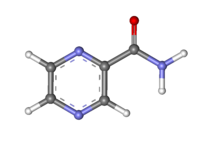 | |
 | |
| Clinical data | |
|---|---|
| Trade names | Rifater, Tebrazid, others[1] |
| AHFS/Drugs.com | Monograph |
| MedlinePlus | a682402 |
| License data |
|
| Routes of administration | By mouth |
| ATC code | |
| Legal status | |
| Legal status |
|
| Pharmacokinetic data | |
| Bioavailability | >90% |
| Metabolism | liver |
| Elimination half-life | 9 to 10 hours |
| Excretion | kidney |
| Identifiers | |
| |
| CAS Number | |
| PubChem CID | |
| IUPHAR/BPS | |
| DrugBank | |
| ChemSpider | |
| UNII | |
| KEGG | |
| ChEBI | |
| ChEMBL | |
| NIAID ChemDB | |
| CompTox Dashboard (EPA) | |
| ECHA InfoCard | 100.002.470 |
| Chemical and physical data | |
| Formula | C5H5N3O |
| Molar mass | 123.115 g·mol−1 |
| 3D model (JSmol) | |
| |
| |
| (verify) | |
Pyrazinamide is a medication used to treat tuberculosis.[2] For active tuberculosis, it is often used with rifampicin, isoniazid, and either streptomycin or ethambutol.[3] It is not generally recommended for the treatment of latent tuberculosis.[2] It is taken by mouth.[1]
Common side effects include nausea, loss of appetite, muscle and joint pains, and rash.[2][4] More serious side effects include gout, liver toxicity, and sensitivity to sunlight.[2] It is not recommended in those with significant liver disease or porphyria.[3] It is unclear if use during pregnancy is safe but it is likely okay during breastfeeding.[3] Pyrazinamide is in the antimycobacterial class of medications.[2] How it works is not entirely clear.[2]
Pyrazinamide was first made in 1936, but did not come into wide use until 1972.[5] It is on the World Health Organization's List of Essential Medicines.[6] Pyrazinamide is available as a generic medication.[2]
- ^ a b Hamilton R (2015). Tarascon Pocket Pharmacopoeia 2015 Deluxe Lab-Coat Edition. Jones & Bartlett Learning. p. 415. ISBN 9781284057560.
- ^ a b c d e f g "Pyrazinamide". The American Society of Health-System Pharmacists. Archived from the original on 20 December 2016. Retrieved 8 December 2016.
- ^ a b c World Health Organization (2009). Stuart MC, Kouimtzi M, Hill SR (eds.). WHO Model Formulary. World Health Organization. pp. 136, 140, 594, 608. hdl:10665/44053. ISBN 978-9241547659.
- ^ Lewis SM, Dirksen SR, Heitkemper MM, Bucher L, Harding M (5 December 2013). Medical-surgical nursing : assessment and management of clinical problems (9th ed.). St. Louis, MO: Mosby. ISBN 978-0-323-10089-2. OCLC 228373703.
- ^ Donald PR, van Helden PD (2011). Antituberculosis Chemotherapy. Karger Medical and Scientific Publishers. p. 8. ISBN 978-3805596282. Archived from the original on 10 September 2017.
- ^ World Health Organization (2019). World Health Organization model list of essential medicines: 21st list. Geneva: World Health Organization. hdl:10665/325771. WHO/MVP/EMP/IAU/2019.06. License: CC BY-NC-SA 3.0 IGO.